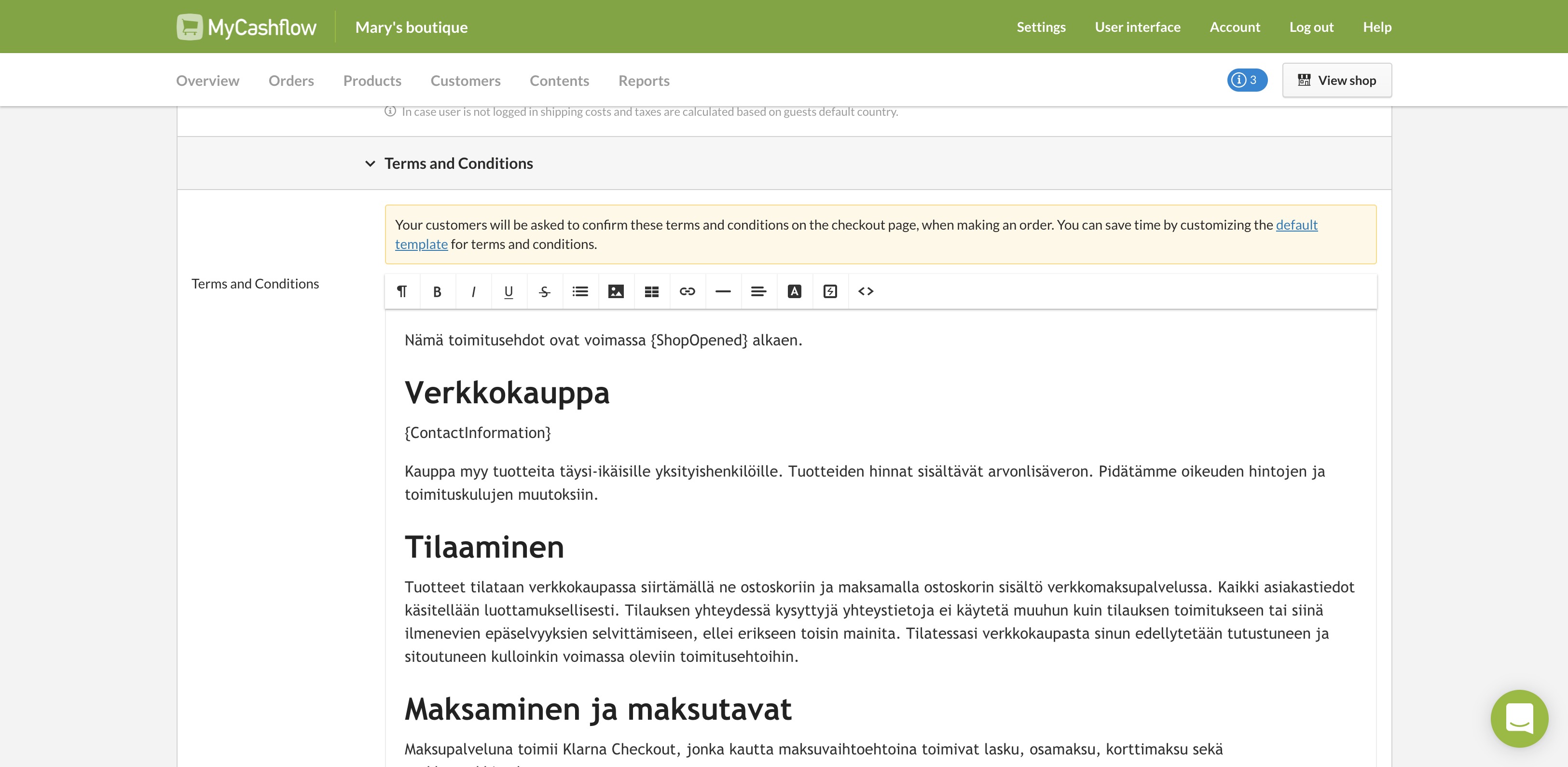All online stores are required by law to have two documents: shipping conditions {i>and<i} a privacy notice. In this chapter of the quick guide, you will learn how to create these documents in MyCashflow, and where to find more information on compiling the texts.
One of the most important qualities of an online store is credibility. From the customer point of view, it means that there should be enough information available on your online store.
The law requires an online store administrator to provide certain information about his or her company, in addition to which it is useful to cover the activities of your company in general, so that your customers get a clear picture of your online store.
Creating a privacy notice
In MyCashflow, customers can create user accounts in online stores, which means that your online store will collect and store user details. Because you will process personal data, you must provide a privacy notice in which you'll explain what your online store does to comply with EU's General Data Protection Regulation (GDPR).
You should regard the duty to provide a privacy notice as a positive thing, because all information you provide to your customers will add to your store's credibility, reliability and transparency as well as help you to earn your customers' trust.
It is good to include the following information in the privacy notice:
- openly and clearly, at least the name and contact information of your company and of the data protection officer if you have one, as well as a description of what kind of personal data your company intends to process
- the purpose for which your company processes personal data
- the legal basis for processing personal data
- how long the data will be stored
- other organizations or people who can be given access to the data
- whether personal data are transferred outside the EU
- the data protection rights of an individual
- the right to lodge a complaint with a data protection authority
- the right to withdraw consent at any time if the processing is based on consent
- information about automated decision making and processing-related logic
Source: Tietosuoja.fi/en.
There is no standard template for a privacy notice but you can use the information provided on the Finnish Data Protection Ombudsman's GDPR page to write yours.
You can also use other online stores' privacy notices as models.
- the contact form
- the availability notification form
- the registration form
- the newsletter subscription form
- the password reset form
It is best to add the privacy notice as a content page in MyCashflow:
Once you've added a separate page for the privacy notice, go to the page and select the page you've created in the Privacy Notice menu.
The page will be displayed under the address https://STORE-NAME.mycashflow.fi/privacy and the link to the page will be added to all forms used for collecting personal data (e.g. the customer information form at checkout and the contact request form).
Terms and Conditions
Your online store must have publicly available shipping conditions, which your customers will be able to read before placing orders. Shipping conditions discuss subjects such as payment and shipping methods and rates, shipping times, returns, and other sales-related topics.
The Finnish Consumer Rights Directive, implemented in 2014, defines what kind of information an online store has to provide consumers with. Some of the information has to be present in shipping conditions. Get familiar with the following materials to gain a clear understanding of information that an online store needs to supply to consumers:
- Online merchant's checklist regarding the amended legislation (only in Finnish)
- Consumer Ombudsman’s Guidelines (Finnish only)
Creating your shipping conditions should not be regarded as a sad duty – on the contrary: thorough shipping conditions usually have a positive impact on your customers' shopping experience and help to create the impression of a professional and credible store.
In a monolingual online store, you can write the shipping conditions in the admin panel's field on the Shipping conditions page.

MyCashflow's default shipping conditions are provided in the field, so that you can modify them according to your store's needs.
Do not remove or edit tags in curly brackets, e.g. {ShopOpened} and {ContactInformation}. These are used to display information about the store. The tags mentioned above display the store's opening date and contact information.
The default shipping conditions mention the Klarna service. If you are not going to use Klarna as a payment method in your store, remove these mentions and replace them with text that describes payment methods available in your store.
If you decide at some point to make your store multilingual, read more about it in our user guide.
Return policy
MyCashflow online stores contain a default return policy that defines the customer's right to return products to the online store.
By default, the return policy is added to the order confirmation message that is sent automatically to the customer after they place an order.
As such, the return policy may not necessarily suit your online store. Return costs may be among the things you want to modify according to your store's needs.
You can edit the return policy on the page:




